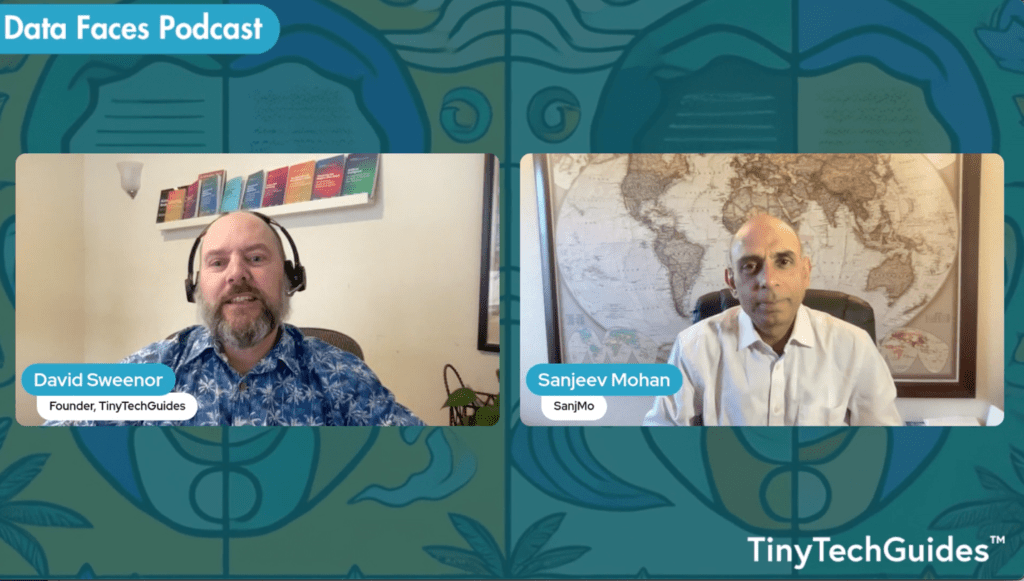
Beyond Predictions: Exploring the Creative and Analytical Sides of AI
Last year, when I wrote Beyond the Hype: Towards a Pragmatic Definition of AI, OpenAI’s ChatGPT was just starting to turn heads. Fast forward to today, the promises of generative AI are at their zenith. The analyst firm McKinsey predicts that generative artificial intelligence (AI) will add up to 4 trillion dollars to the global economy.[1] Although generative AI will impact every industry, business function, and department, the most significant impacts will be seen in sales, marketing, software development, customer operations, and product R&D. MIT estimates that generative AI will boost worker productivity by 40%.[2] For more on generative AI business applications, see my post, Business Applications of Generative AI.
Although generative AI is certainly transformative, its power is magnified tenfold or more when coupled with traditional AI. I’ve had many questions from business leaders, educators, and friends on how generative AI differs from traditional AI. This blog will compare and contrast traditional AI (which some refer to as predictive AI) with generative AI and share how it amplifies their effectiveness when combined.
Back to Basics: What is Artificial Intelligence?
Analytics 101
Before delving into AI, let’s ensure we are aligned with our terminology. Analytics is generally categorized into four broad categories: descriptive, diagnostic, predictive, and prescriptive. Most organizations use a combination of analytic types to solve specific business problems and gain a competitive advantage. Businesses have a few basic types of questions, which have been mapped to each analytical category.
What happened?
- Analytic type: descriptive analytics
- Example use case: what was last week’s sales?
Why did it happen?
- Analytic type: diagnostic analytics
- Example use cases: what caused our sales to increase last week? What were the top 10 defects that caused our yield to decrease in the previous month? What are the primary reasons insurance claims are being filed?
What is likely to happen?
- Analytic type: predictive analytics (a.k.a predictive AI)
- Example use cases: given past trends, what is the next quarter’s sales forecast? When is the equipment in our factory going to break down? Given current conditions, how long do we expect elevated insurance claims to persist?
What should we do?
- Analytic type: prescriptive analytics
- Example use cases: given our sales projections, we recommend running incentives to our sales teams to encourage selling a specific bundle. Given the likelihood of equipment failure, we recommend performing maintenance next week. To reduce customer churn, please offer customers the promotion code PROMO20 to stay with our company.
Now that we have a common vernacular, let’s define AI.
AI Defined
In my first TinyTechGuide, Artificial Intelligence: An Executive Guide to Success, I developed a practical definition of artificial intelligence since an adequate one did not exist. Having been in the data, analytics, and AI domain my entire career, both as a practitioner and marketer, there was no clear definition of AI. In my mind, the definition is quite simple:
Artificial Intelligence = Data + Analytics + Automation
Figure 1.1: A Pragmatic Definition of AI

That’s it. Just data, analytics, and automation. Applications include:
- Using chatbots and conversational AI to accomplish specific tasks like opening a bank account or ordering a pizza. (This improves the quality of customer service and lowers operating costs.)
- Using predictive analytics and machine learning algorithms to hyper-personalize offers, detect anomalies like fraud, or recommend what to watch next on Netflix. (This leads to higher revenue, lower costs, and improved customer satisfaction.)
- Using computer vision and optical character recognition (OCR) to extract text data from receipts, invoices, and PDF files to automate warranty claims or sift through siloed data sources to select suitable candidates for pharmaceutical clinical trials. (This can lower costs, improve satisfaction, and reduce risks.)
- Using natural language processing (NLP) and text analytics to identify key themes and sentiments in a corpus text data. Better understanding the voice of the customer leads to improving service quality and recommending next-best actions. (This can increase revenue, reduce manual intervention, and improve efficiency.)
- Applying computer vision to automatically scan images and identify anomalies in medical images or manufacturing defects. (This can improve diagnosis, reduce costs, and improve quality.)
Predictive Analytics
Now that we have a better understanding of the different types of business questions that analytics can answer, let’s turn our focus to predictive analytics—the foundation of technology used for AI. The most common method employed in AI is machine learning (ML) technology. With ML, data scientists will use the terms ‘models’ and ‘model deployment.’ A model is nothing more than a mathematical formula or algorithm.
Remember the formula “y=mx + b” from basic algebra? This is an equation or model for a straight line where m is the slope of the line and b is the y-intercept (where it crosses the y-axis). Now, we need not go into details about how to draw the best-fit line through a set of points on a 2D (x/y) graph, but it involves minimizing some sort of error function. All you really need to know is that there are known methods for performing these computations. And these days, after formulating the problem and preparing your data, the computer does most of the work! In fact, generative AI can help with this, but let’s not get ahead of ourselves.
Now, there are many different types of algorithms that organizations use. The formulas may be more complex than our equation for a straight line, but modern software handles this complexity for data scientists. In general, most models are created by “training” them on historical data. The resulting model is then deployed to a business system, and the algorithm is fed data it has never seen before. The formula’s output, called a score, is simply a probability or likelihood that something will happen. This probability could be the likelihood that a transaction is fraudulent, the probability that you will click on an ad served to you in your social media feed, or the likelihood that your equipment will break down. Figure 1.2 conceptualizes how predictive analytics works and how it’s used to make business decisions.
Figure 1.2: Illustration of Predictive Analytics

What is Generative AI?
Unlike traditional AI, which deals primarily with numeric data and occasionally small amounts of text, generative AI refers to a category of AI systems capable of generating completely novel content on their own. Traditional AI focuses on analyzing historical data and making future numeric predictions, while generative AI allows computers to produce brand-new outputs that are often indistinguishable from human-generated content.
At the core of most generative AI systems are foundation models (FMs) and large language models (LLMs)—which are neural networks trained on massive volumes of data–most of which was vacuumed up from the internet without regard for privacy and intellectual property (IP) rights. By learning the patterns and structures of human language, computer code, images, video, and music, LLMs can contextually understand concepts and generate new content, which shares statistical similarities with the original corpus it was trained on. When prompted with a few words or sentences, LLMs can produce paragraphs, stories, poems, functional code, synthetic data, photorealistic images, original music, and video.
In a nutshell, generative AI has catapulted us beyond the numbers. Generative AI can create new content — be it a blog, a tooltip, a support article, a term paper, an image, or even a piece of music. Generative AI is certainly based on numbers, but how you interact with it, and the generated output is the game changer. You can feed it a corpus of documents and ask it in nearly a hundred different languages to analyze the patterns, similarities, or differences across the documents. You can quickly summarize the documents and ask for key points, exciting moments, and key quotes. Using nothing more than an internet browser and your natural ability to ask questions, your creativity is no longer bounded by your innate skills. These questions, known as prompts, allow anyone to create prose, write code, compose songs, and generate art that the Old Masters would envy.
En masse, anyone can now generate product descriptions, recruiting emails, personalized ad copy, RFP responses, software release notes, and many other use cases that your business often needs. You can ask generative AI to create images for your presentations, software code, or even generate background music for your how-to videos. There are several different mode types, which include text models, code models, synthetic data models, chemical language models (CLMs), image models, audio models, and video models, which I discussed in The Six Generative AI Model Types & Real-World Use Cases.
Now, with all of the buzzwords, algorithms, and terms floating around, perhaps a way to think about this:
Figure 1.3: Relationship Between AI and Generative AI

Key Differences
Now, let’s discuss the critical differences between traditional AI and generative AI.
What Does It Do?
- Generative AI: Understands context and generates novel human-like content (e.g., text, code, music, audio, video, data, etc.)
- Traditional AI: Based on historical patterns in data, predicts outcomes for specific use cases (e.g., numeric predictions)
How is it Applied?
- Generative AI: Applies to various general use cases and applications (e.g., answer complex questions, create net-new images, audio, video)
- Traditional AI: Narrowly defined–use case specific (e.g., detect fraud, play chess, recognize an anomaly in an image)
What Data is Used to Train the Model?
- Generative AI: Data harvested from the internet
- Traditional AI: Carefully curated data for specific purposes
How is it Delivered?
- Generative AI: More human interfaces (e.g., chat interfaces via apps and web browsers
- Traditional AI: Specialized use case-specific applications (e.g., BI reports, dashboards, call center screens, etc.)
Who Can Use It?
- Generative AI: Anyone
- Traditional AI: Generally requires knowledge and specialized skills
Figure 1.4: Generative AI vs. Traditional AI

So, in summary, the central differences between generative AI and traditional AI are:
- General use cases vs. specialized use cases
- Generate net new content vs. predicting numeric outputs or describing historical data
- Approachable, multi-modal (text, image, audio, video) vs. less approachable, smaller number of input types.
Conclusion
As technology advances, traditional AI and generative AI will work together. Generative AI will be used to simplify and streamline human-machine interaction and to create applications using traditional AI. In other words, they will be used in tandem, rather than in isolation. Now, many of the articles I’ve read over the past few months essentially say that generative AI is going to help with just about everything.
For example, take a typical supply chain use case like demand forecasting. There are countless articles describing how generative AI can help with demand forecasting. Most of these articles claim that generative AI can help with data augmentation, scenario analysis, and more advanced pattern recognition. The one issue I would point out is that these can all be done today–without the assistance of generative AI. For data augmentation, do businesses think that generative AI will magically fix all of their data issues? If it’s not cataloged and is a mess, good luck. For scenario analysis and advanced pattern recognition, again, all in today’s toolkit.
What’s different with generative AI is the number of people that can help address these issues. Assuming organizations have findable, well-organized data, I can now ask the application to help create forecasts for specific periods and do scenario analysis. We can ask it to use ML algorithms for the forecast rather than statistical methods–changing it from a univariate to a multivariate model. But, when you ask these questions, it will write Python code to analyze the data and create output graphics–thus leveraging traditional AI.
Businesses planning to implement their generative AI projects should step back, take a breath, and think holistically about the business problem to be solved and work backward from that. What is the minimum viable data needed, how will your business process change, and how will it help us achieve our organizational goals? Remember, generative AI is not a panacea; it’s simply another tool in the toolbox.
If you enjoyed this article, sign up for the newsletter at the bottom of this page and consider following me on Medium and LinkedIn.
If you’re interested in this topic, consider TinyTechGuides’ latest report, The CIO’s Guide to Adopting Generative AI: Five Keys to Success or Artificial Intelligence: An Executive Guide to Make AI Work for Your Business.
[1] Mckinsey & Company. 2023. “Economic Potential of Generative AI | McKinsey.” Www.mckinsey.com. June 14, 2023. https://www.mckinsey.com/capabilities/mckinsey-digital/our-insights/the-economic-potential-of-generative-ai-the-next-productivity-frontier#introduction.
[2] Somers, Meredith. 2023. “How Generative AI Can Boost Highly Skilled Workers’ Productivity | MIT Sloan.” Mitsloan.mit.edu. October 17, 2023. https://mitsloan.mit.edu/ideas-made-to-matter/how-generative-ai-can-boost-highly-skilled-workers-productivity.



